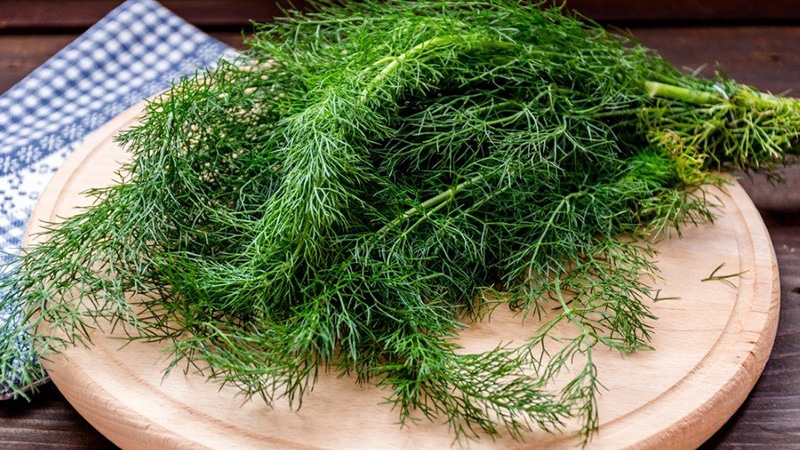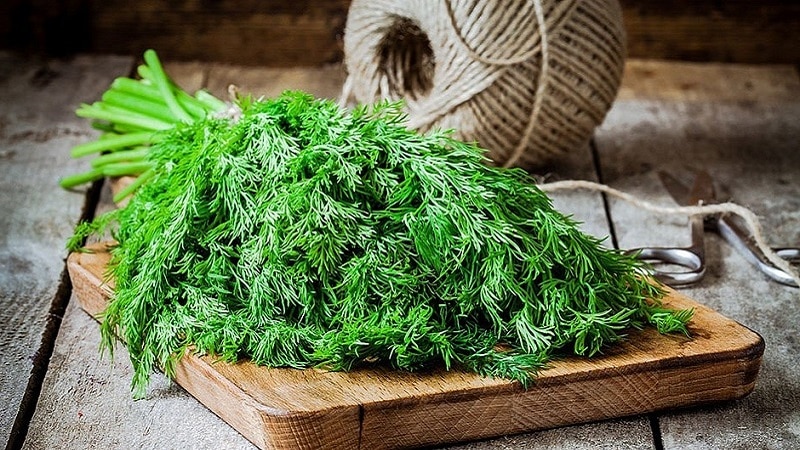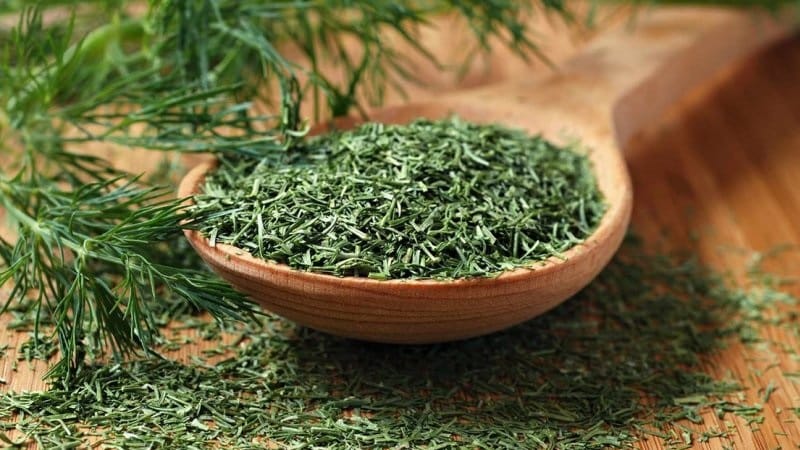How many calories are in 100 grams of dill?
Dill (literally from Greek - fragrant) - a spicy herb, known in almost all countries. In ancient cultures, winners were given wreaths and lovers were given bouquets made from dill.
Today it is a favorite spice, greenery, without which not a single housewife can do. It contains twice as much calcium as milk. Moreover, dill holds the record for the presence of vitamin C: there is more of this compound in the plant than in citrus fruits. What else is useful for dill, what is its composition and energy value, methods of use and storage - we will tell you in the article.
Chemical composition, trace elements and vitamins of dill

Ratio of proteins, fats, carbohydrates: 26.9%, 5.4% and 67.7%. Below is the number of dill components per 100 g of product.
- proteins – 3.46 g;
- fats – 1.12 g;
- carbohydrates – 4.92 g;
- dietary fiber (fiber) – 2.1 g;
- ash – 2.45 g;
- water – 85.95 g.
Fatty acid:
- palmitic (0.05 g) – responsible for skin renewal and regeneration;
- stearic (0.01 g) – moisturizes the skin, protects from ultraviolet rays;
- oleic (0.8 g) – reduces the risk of heart disease, diabetes, lowers blood pressure;
- linoleic (0.08 g) – participates in lipid metabolism, good for the brain and liver cells;
- linolenic acid (0.01 g) – inhibits the growth of cancer cells, is necessary for strengthening hair and nails.
Fatty acids support heart function, help normalize blood circulation, mobilize the body's defenses, prevent the formation of tumors, and strengthen the immune system.
Macroelements are responsible for the condition of the skin, nails, hair, strengthen the walls of blood vessels, and prevent their fragility:
- potassium – 740 mg;
- calcium – 209 mg;
- magnesium – 55 mg;
- sodium – 61 mg;
- phosphorus – 69 mg.
Microelements promote cell construction, ensure the functioning of the endocrine system, and strengthen joints:
- iron – 6.6 mg;
- manganese – 1.26 mg;
- copper – 0.15 mg;
- zinc – 0.91 mg.
Vitamins:
- vitamin A (retinol equivalent) is a natural antioxidant, increases the body's defenses, promotes tissue restoration, and has a beneficial effect on the sex glands;
- vitamin C (ascorbic acid) – necessary for blood vessels, bones, connective tissue, removes toxins, protects against infections, lowers cholesterol;
- vitamin E (tocopherol) – antioxidant, rejuvenates, slows down cell aging, improves blood flow, prevents the formation of plaques and blood clots, and is beneficial for the genitourinary system;
- B1 – thiamine stimulates brain function, is necessary for the heart and endocrine system, and is beneficial for nerve cells;
- B2 – riboflavin is necessary for hormones and red blood cells, promotes tissue growth and renewal;
- B3 (PP) – niacin ensures protein metabolism, normalizes the functioning of the gastrointestinal tract and pancreas, reduces blood pressure, is a vasodilator, and affects blood composition;
- B5 – pantothenic acid is necessary for metabolism, regulates intestinal function, supports the nervous and immune systems, heals wounds;
- B9 – folic acid normalizes the process of hematopoiesis, optimizes the function of the digestive system, promotes cell growth and division, and participates in lipid metabolism;
- B6 – pyridoxine is necessary for the production of hemoglobin and hormones, relieves numbness, cramps, muscle spasms, and normalizes the functioning of the central nervous system.
Essential amino acids: arginine, valine, isoleucine, leucine, lysine, in small quantities histidine, methionine, threonine, tryptophan, etc.
Reference. Essential amino acids are structural components of protein that the body itself cannot synthesize. Necessary for the regulation of hormonal levels and the functioning of the nervous system.
Essential amino acids: aspartic, glutamic acid, alanine, glycine, proline, serine, tyrosine.
Reference. The body receives non-essential amino acids in finished form from food, they stabilize metabolic processes, promote the growth of muscle tissue, and play the role of neurotransmitters - conductors of nerve impulses.
Calorie content of dill per 100 g

In dietetics, dill is classified as a product with negative energy value. For those who limit themselves to high-calorie foods, dill is simply irreplaceable. In addition, this greenery, accessible to everyone, replenishes “vitamin” hunger and supports the body throughout the year.
Fresh
The energy value per 100 g is only 38-40 kcal, depending on the climate, conditions and place of cultivation. One branch contains 10 g, and a bunch contains 15-20 g. Even if you are on a strict diet, you can season any dishes with dill; this will not affect your daily calorie intake.
Important. Immunologists and nutritionists recommend consuming mainly fresh dill, as it retains more nutrients.
Dried
About 15-20 years ago, housewives stocked up on dill for the winter in the only way - by drying finely chopped greens.If you don’t have a good freezer at home, this method is still the most affordable and simplest.
Important. Properly dried dill, without exposure to direct sunlight, retains 95-98% of its spicy smell and beneficial properties.
The nutritional value of dried dill changes due to loss of moisture (per 100 g) - 78-80 kcal.
It is recommended to dry the seeds, they give a stronger smell, they contain three times more fat, the nutritional and energy value of dill seeds reaches 300 kcal per 100 g.
Frozen
Today, freezing is the most optimal way to preserve greens for a long period.
Important. When deep frozen, without periodic defrosting, dill retains vitamins and nutrients 100%.
The calorie content and ratio of proteins, fats and carbohydrates in frozen dill is also preserved - 38-40 kcal.
Freeze clean, dry, finely chopped greens, store in special containers or in a plastic bag.
Canned
Dill is added to canning exclusively as a spice; the calorie content of the herbs does not change (up to 40 kcal per 100 g), but it almost completely loses its beneficial properties.
Pickled
Any marinade and brine is subjected to heat treatment, dill loses its beneficial properties, vitamins and minerals, the calorie content remains unchanged - 38-40 kcal per 100 g.
Dill oil
Dill oil is an oil extract prepared from dill or fennel seeds.
Reference. Fennel (dill or Voloshsky) is an essential oil plant of the Apiaceae family.
At home, the seeds are pounded in a wooden mortar by hand or crushed with a coffee grinder, olive oil is added in equal proportions, and stored in a cool, dark place.
In industry, dill oil is obtained by steam distillation. The raw material is pre-dried seeds. The finished product is a colorless or greenish volatile liquid with a spicy, sweetish aroma.
The energy value of dill oil is 890 kcal per 100 g. In 1 tsp. – 5 g., in 1 tbsp. l. – 16 years
The benefits and harms of dill

Medically dill is an invaluable product:
- rich in retinol, it ensures growth and metabolism function, prevents eye diseases;
- thanks to the vitamin composition and essential oils, it improves well-being, activates mental activity, relieves nervousness and tension;
- has a beneficial effect on cellular metabolism and cell structure;
- prevents hair loss, brittle nails, maintains the condition of the skin and mucous membranes;
- normalizes the activity of the nervous system, mobilizes the body's defenses;
- prevents blockage of blood vessels, strengthens capillaries, increases hemoglobin, cleanses the blood and blood vessels;
- micro- and macroelements participate in hematopoiesis processes, improve blood composition, reduce sugar and cholesterol levels, support heart function;
- dietary fiber normalizes intestinal function, gently removes toxins and heavy metal salts from the body;
- dill water relieves babies from colic;
- folic acid reduces fat deposition on internal organs, folates normalize lipid metabolism, indispensable for bone marrow;
- Dill greens are a natural immunomodulator, reduce the risk of malignant tumors, block inflammatory processes;
- good for women – prevents uterine bleeding, normalizes the menstrual cycle;
- tincture seeds treat bronchitis, use as an expectorant.
This product has no direct contraindications or restrictions.
Considering the properties of the plant, composition and action, it is recommended to use it with caution in the following cases:
- with low blood pressure, the main danger is excessive consumption;
- in cases of food allergies, when symptoms appear - itching, sneezing, watery eyes, rash on the body - dill is excluded from the diet.
Features of application
In addition to cooking, dill, essential oil, and seeds are used in folk medicine:
- tincture of seeds treats seasickness;
- essential oil is added to homeopathic remedies;
- used as massage oil in the fight against cellulite;
- for acne, wipe problem areas of the skin with tincture of dill seeds;
- gruel from pureed fresh herbs heals wounds and burns, relieves inflammation of the skin;
- compresses from a decoction of seeds relieve eye fatigue due to overstrain;
- For bloating, it is recommended to chew dill seeds.
Fennel essential oil is used in the soap industry, in the production of perfumes and cosmetics, for example, creams, colognes, toothpaste, and aftershave products.
In the food industry, dill oil is used to make alcoholic beverages: brandy, vermouth, liqueurs, etc. - for richness of taste.
Conclusion
Dill is not just a fragrant spice with a unique smell and taste, it is an invaluable gift of nature, a green first aid kit, a guarantee of health, beauty and longevity. It is useful for a wide range of diseases and is indicated for people of all ages, starting from infancy.